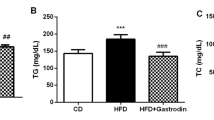Abstract
The role of antioxidant supplementation with vitamin E in the prevention of atherosclerosis has been a topic of considerable recent interest. The relevance of vitamin E for macrophage-derived foam cell formation, a hallmark of atherosclerosis, however, has not been unequivocally resolved. Here, we investigated the effect of Oxidized LDL (ox-LDL) and vitamin E on lipid accumulation and total cholesterol content in U937 macrophages, reactive oxygen species generation and expression of nuclear factor-κB (NF-κB) signaling pathway. The results showed that the mRNA expression and protein levels of P-selectin were evident in U937 macrophages treated with ox-LDL and vitamin E, which indicating that expression of P-selectin is important in macrophage-derived foam cell formation. Moreover, P-selectin changes in ox-LDL-induced foam cell formation can be mediated by vitamin E through activities of nuclear NF-κB activated by serine phosphorylation of NF-κB inhibitor α, suggesting that activation of NF-κB pathway by macrophages may occur. Taken together, these data suggested that vitamin E can prevent ox-LDL-induced foam cell macrophages formation through modulating the activities of oxidative stress-induced NF-κB pathway.







Similar content being viewed by others
Abbreviations
- DCFH-DA:
-
20,70-Dichlorofluorescein-diacetate
- ECs:
-
Endothelial cells
- FCMs:
-
Foam cell macrophages
- IκBa:
-
NF-κB inhibitor α
- NF-κB:
-
Nuclear factor-κB
- ORO:
-
Oil red O
- ox-LDL:
-
Oxidized LDL
- ROS:
-
Reactive oxygen species
References
Bousette N, D’Orleans-Juste P, Kiss RS, You Z, Genest J, Al-Ramli W, Qureshi ST, Gramolini A, Behm D, Ohlstein EH, Harrison SM, Douglas SA, Giaid A (2009) Urotensin II receptor knockout mice on an ApoE knockout background fed a high-fat diet exhibit an enhanced hyperlipidemic and atherosclerotic phenotype. Circ Res 105:686–695
Rader DJ, Daugherty A (2008) Translating molecular discoveries into new therapies for atherosclerosis. Nature 451:904–913
Yilmaz O, Celik S, Cay M, Naziroğlu M (1997) Protective role of intraperitoneally administrated vitamin E and selenium on the levels of total lipid, total cholesterol, and fatty acid composition of muscle and liver tissues in rats. J Cell Biochem 64:233–241
Libby P, Ridker PM, Hansson GK (2011) Progress and challenges in translating the biology of atherosclerosis. Nature 473:317–325
Naziroglu M, Brandsch C (2006) Dietary hydrogenated soybean oil affects lipid and vitamin E metabolism in rats. J Nutr Sci Vitaminol (Tokyo) 52:83–88
Poli G, Sottero B, Gargiulo S, Leonarduzzi G (2009) Cholesterol oxidation products in the vascular remodeling due to atherosclerosis. Mol Aspects Med 30:180–189
Libby P (2002) Inflammation in atherosclerosis. Nature 420:868–874
Wang F, Okamoto Y, Inoki I, Yoshioka K, Du W, Qi X, Takuwa N, Gonda K, Yamamoto Y, Ohkawa R, Nishiuchi T, Sugimoto N, Yatomi Y, Mitsumori K, Asano M, Kinoshita M, Takuwa Y (2010) Sphingosine-1-phosphate receptor-2 deficiency leads to inhibition of macrophage proinflammatory activities and atherosclerosis in apoE-deficient mice. J Clin Invest 120:3979–3995
Naziroğlu M, Simşek M, Simşek H, Aydilek N, Ozcan Z, Atilgan R (2004) The effects of hormone replacement therapy combined with vitamins C and E on antioxidants levels and lipid profiles in postmenopausal women with Type 2 diabetes. Clin Chim Acta 344:63–71
Wing LY, Chen YC, Shih YY, Cheng JC, Lin YJ, Jiang MJ (2009) Effects of oral estrogen on aortic ROS-generating and -scavenging enzymes and atherosclerosis in apoE-deficient mice. Exp Biol Med (Maywood) 234:1037–1046
Hong L, Xie ZZ, Du YH, Tang YB, Tao J, Lv XF, Zhou JG, Guan YY (2011) Alteration of volume-regulated chloride channel during macrophage-derived foam cell formation in atherosclerosis. Atherosclerosis 216:59–66
Saremi A, Arora R (2010) Vitamin E and cardiovascular disease. Am J Ther 17:e56–e65
Cabrero A, Cubero M, Llaverías G, Alegret M, Sánchez R, Laguna JC, Vázquez-Carrera M (2005) Leptin down-regulates peroxisome proliferator-activated receptor gamma (PPAR-gamma) mRNA levels in primary human monocyte-derived macrophages. Mol Cell Biochem 275:173–179
Vogel CF, Sciullo E, Matsumura F (2004) Activation of inflammatory mediators and potential role of ah-receptor ligands in foam cell formation. Cardiovasc Toxicol 4:363–373
Zabel U, Schreck R, Baeuerle PA (1991) DNA binding of purified transcription factor NF-kappa B. Affinity, specificity, Zn2+ dependence, and differential half-site recognition. J Biol Chem 266:252–260
Wang L, Yu CJ, Liu W, Cheng LY, Zhang YN (2011) Rosiglitazone protects neuroblastoma cells against advanced glycation end products-induced injury. Acta Pharmacol Sin 32:991–998
Liu X, Ntambi JM (2009) Atherosclerosis: keep your macrophages in shape. Nat Med 15:1357–1358
Ferreira V, van Dijk KW, Groen AK, Vos RM, van der Kaa J, Gijbels MJ, Havekes LM, Pannekoek H (2007) Macrophage-specific inhibition of NF-kappaB activation reduces foam-cell formation. Atherosclerosis 192:283–290
Webb NR, Moore KJ (2007) Macrophage-derived foam cells in atherosclerosis lessons from murine models and implications for therapy. Curr Drug Targets 8:1249–1263
Kuhn AM, Tzieply N, Schmidt MV, von Knethen A, Namgaladze D, Yamamoto M, Brüne B (2011) Antioxidant signaling via Nrf2 counteracts lipopolysaccharide-mediated inflammatory responses in foam cell macrophages. Free Radic Biol Med 50:1382–1391
de Winther MP, Kanters E, Kraal G, Hofker MH (2005) Nuclear factor kappaB signaling in atherogenesis. Arterioscler Thromb Vasc Biol 25:904–914
Harhaj EW, Dixit VM (2011) Deubiquitinases in the regulation of NF-κB signaling. Cell Res 21:22–39
Xanthoulea S, Curfs DM, Hofker MH, de Winther MP (2005) Nuclear factor kappa B signaling in macrophage function and atherogenesis. Curr Opin Lipidol 16:536–542
Lawrence T, Bebien M, Liu GY, Nizet V, Karin M (2005) IKKalpha limits macrophage NF-kappaB activation and contributes to the resolution of inflammation. Nature 434:1138–1143
Acknowledgments
The authors would like to thank members of professor Zong-Gui Wu’s laboratory for their helpful discussion and critical reading of the manuscript.
Conflict of interest
The authors have no financial conflicts of interest.
Author information
Authors and Affiliations
Corresponding author
Additional information
Zhi-Gang Huang and Chun Liang contributed equally to this study.
Rights and permissions
About this article
Cite this article
Huang, ZG., Liang, C., Han, SF. et al. Vitamin E ameliorates ox-LDL-induced foam cells formation through modulating the activities of oxidative stress-induced NF-κB pathway. Mol Cell Biochem 363, 11–19 (2012). https://doi.org/10.1007/s11010-011-1153-2
Received:
Accepted:
Published:
Issue Date:
DOI: https://doi.org/10.1007/s11010-011-1153-2




